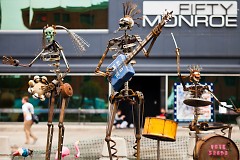In an article in the Grand Rapids Press, Joseph Becherer makes some intriguing comparisons between ArtPrize and Renaissance Florence. Becherer relates that the Florentine public had a high appreciation for quality in art which “set the community afire and attracted the world’s attention.”
He goes on to observe that “one of the important but manageable challenges at hand for ArtPrize in dialogue with the arts and community leaders in Grand Rapids is to really double down on issues and ideas about quality for the sake of the entire community and its reputation.” In this way we could aspire to be like Florence; our community could be an artworld beacon with a reputation for appreciating only the best that art has to offer.
I get it. I can see the appeal, I really can. Why wouldn’t we want everything to be the highest quality art? In Becherer’s words we would be “elevating society and creating a culture of distinction.”
But I don't want it. This is why:
Most art competitions are exclusive. Different styles of art have their different shows and experts. The juror makes sure that the art is the right kind for the show, and determines the quality based on personal opinion. If you enter a performance work into a jurored competition of northeast maritime painters, guess what? You don't get in. If you enter the right kind of work but the juror dislikes it you don’t get in either. These types of shows are efficient at weeding out the wrong kind of art and sorting out what experts deem to be quality. But they also foster a fracturing of the art community. The visual arts is full of style ghettos, groups who sometimes seem to spend as much time sneering at each other as making art.
ArtPrize engages the entire art community and any viewer who wants to participate. The entire art community. Any viewer. This includes artists working in the latest artworld trends and artists from outside these circles who are making junk metal sculptures and possibly contributing to the “myriad carnival-like environments” at ArtPrize. It includes viewers who like thought-provoking installation art and viewers who like the kind of work that will never make the expert’s short lists.
We need all the artwork, even the work Becherer sees as the “significant amount of, well, not so good stuff penetrating deeply into the top 100, even the Top 10.”
We need it because we can learn from each other. I have enormous respect for Becherer and he is a fantastic resource for learning about how to look at art. I have the highest admiration for his work at Meijer Gardens. There are many others who can guide us similarly toward powerful and moving work. But conversely, ArtPrize gives them the opportunity to learn from artists who come from outside the academic training and artistic expectations of the elite. It gives them the opportunity to learn why some people love styles that in the eyes of most art experts are “not so good.” To learn why when you break down barriers and trust people to come and look art art on their terms and not yours they flock to the event by the thousands. ArtPrize may even spur some experts to question and re-examine cherished methods for judging the quality of art.
We need the entire art community because we should be connected in ways that are both narrow and wide. One of my favorite painters is Stuart Shils. This connects me with a few people who probably look at art in a similar way as myself. Another painter I like is Norman Rockwell, which connects me with many people across a broad spectrum of ages and tastes. This is fine, because sometimes it’s healthy to be alone, and sometimes it‘s good to be part of a larger community. I am confident that some of the work at ArtPrize that I like is work that Becherer would think is low quality. I wouldn’t want it any other way. If we all liked the same things we would have an unvaried and stagnant culture. The ArtPrize community is a community that loves to look at art, but looks at many different kinds of art in many different ways. Once we go down the road of expecting or demanding certain levels of quality we begin to leave behind broad sections of that community.
If it is true about Renaissance Florence, as Becherer says, that “its people valued art too dearly and took themselves and their reputation too seriously to tolerate the entrance of third and fourth gestures into public discourse let alone public spaces,” then that community was impoverished indeed. Grand Rapids and ArtPrize have already done better than that.
The Rapidian, a program of the 501(c)3 nonprofit Community Media Center, relies on the community’s support to help cover the cost of training reporters and publishing content.
We need your help.
If each of our readers and content creators who values this community platform help support its creation and maintenance, The Rapidian can continue to educate and facilitate a conversation around issues for years to come.
Please support The Rapidian and make a contribution today.
